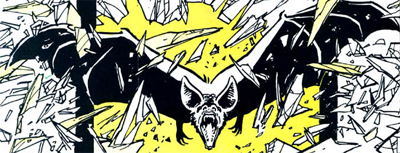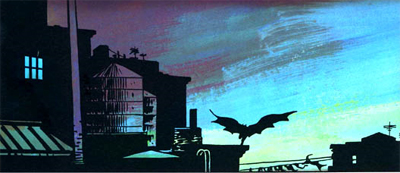This is probably on a shortlist for the best Batman story of all time, alongside Frank Miller’s other definitive work on the character, The Dark Knight Returns. Whereas Millar focused on the eventual end of the character’s crusade against crime, here he focuses on the origin of the character. Expanding from the one-page origin which accompanied Batman #1, Miller brings his keen eye to Batman’s psychology, but also the world in which Batman functions. This isn’t the gothic construction of Tim Burton, but a grimy urban cesspool like Christopher Nolan’s. In the world that Miller carves out for the hero, he greatest opponents aren’t the disfigured freaks who would become his adversaries, but the architecture of greed and corruption that defines Gotham.

Imagine if it had been a seagull that crashed through his window that fateful night...
Miller manages to almost ground the character in reality. His Bruce Wayne is on the edge, on the cusp of sanity. He does well to share his narration with the newly arrived Lieutenant Jim Gordon who offers a compelling view of the institutional corruption and graft which pretty much make change impossible in the city without extreme means. He gives us an almost sane logic behind why an ordinary man would dress as a bat and fight crime. He almost makes us believe that The Batman could exist.
The writer’s cynicism is well noted. He excels at the hard-boiled. One need only look at Sin City to see the idea taken to extremes, but Miller has always enjoyed exploring how an institution can crush the most noble individual, no matter how strong-willed. Compare his work on Daredevil, where the hero can’t tackle the Kingpin because he has so throughly integrated himself within New York’s infrastructure. There’s something tragic about the story of a good man being beaten down. Miller’s particular slant on it, however, is that sometimes a hero needs to beat the city back.
This idea is obviously pushed to excess at times. Some of his protagonists are border-line psychotic (the Batman in The Dark Knight Returns and All-Star Batman comes to mind, to the point that fans have taken to calling him “crazy Steve”) and there are traces of the here. “You’re the one who tried to shoot the cat,” Batman remarks to a police officer, before literally punching him through the wall. Similarly, James Gordon demonstrates he’s tough as nails by taking down a military-trained police officer and leaving him naked. This behaviour is relatively tame by some of the stuff Miller’s other characters do in other stories. Besides, Miller’s Batman is not a healthy man – any more than any individual who dresses up as a giant bat could be considered “healthy”.
Miller gets a lot of credit for saving Batman from the neon camp of the 1960s Adam West television show. Not all of it is entirely due – Denny O’Neil was taking the character back to his roots before Miller showed up. What Miller did do was to re craft the vigilante for a modern generation. It wasn’t just the mob or crime which Batman stood against, it was institutional apathy or even corruption. Here Batman crashes a party at the mayor’s house to deliver a stunning ultimatum: no one is safe. This is a character who operates outside the system not simply to compliment it, but to correct it.
The story is relatively short – told over four issues. But Miller manages to tell his story concisely. Single panels sit in for big, important events. He trusts his readers to know the difference. There is an overarching story – how Jim Gordon comes to trust the vigilante – but it is structured as a series of vignettes, examples of how dirty Gotham is and how overcrowded the gutters must be, and – finally – how Batman himself is inspiring a new breed of criminals. In order to tell so epic a story in so few pages, Miller forsakes some of the corner stones of The Dark Knight Returns. There is relatively little debate on the Batman as a force within the city, good or bad. Miller implies that the city may split over his presence (by making Harvey Dent a covert ally to the vigilante, lying to Gordon to protect him), but he pretty much states that Batman is a force for good in Gotham (almost without qualification). We come to realise that with Gordon, as Gordon realises that Gotham isn’t an ordinary city. You can almost hear somebody uttering, “Forget it Jimbo, it’s Gotham…”
Though it may lack the thematic depth of its counterpart, Year One is a far more compelling story, structured on its own. Miller ramps up the action sequences and the individual characters and motivations, giving us an idea of the impact that the arrival of the masked figure is having on the underworld and the establishment. The story is always building, paced around smaller events leading to larger events and even larger events. It’s a crime thriller at its core, but it’s anchored in two fascinating lead characters.
The Gordon thread that works through the story arguably provides the heart. Gordon is new to the city, struggling to fins his feet – an honest cop in a dishonest town. He has his flaws – it’s implied they got him transferred to Gotham – but he tries to do what is right. Miller gives us one of the best moments in the Gordon/Batman dynamic as he answers why Gordon has never really been too concerned with the identity of the city’s Caped Crusader: he knows, but he has convinced himself that he doesn’t.
This is the Gotham as envisaged by Christopher Nolan in his film series. As much as David Goyer may deny that Batman Begins is not an adaptation of Year One, it does borrow heavily from the book. From the supporting police characters like Commissioner Loeb and Detective Flass through to the “back up” against the SWAT team, there’s a very heavy influence in these pages on the way than Nolan allows his Batman mythos to unfold. It is at least as much an influence on the first movie as The Long Halloween is on The Dark Knight.
The artwork is impressive, dark and brooding and grey, like the city itself. There are streets and gutters and elevated trains and condemned buildings. The story looks very good. The pages drip with atmosphere, and you can get the sense that the city is a cesspool, overflowing with vice and sin. It’s the kind of place which could produce a Batman.
That said, my subsequent re-readings have been somewhat tempered by various factors. The most obvious is Miller’s presentation of women. The man’s writing has been discussed and brutally parodied to hell and back, but I’m still not sure why Miller is so fixated on the idea of Catwoman as a prostitute. I mean, she’s no more or less bondage-themed than your average female comic book character, and Miller has consistently portrayed her associated with the world’s oldest profession – here and in The Dark Knight Returns. I don’t feel it adds anything the character, and just seems a strange addition. It doesn’t help that the only other major female role goes to the woman who Jim Gordon cheats on his wife with.
This has troubled me a little, but I’m willing to write it off as the kind of device common in these sorts of stories. It’s nowhere near as omni-present as it is in his Sin City work, nor is it as blatantly awkward as in All-Star Batman and Robin. In fact, if I had only read this work, I would have assumed Miller was emulating the style of the gritty genre he’s working in. It’s only when you step back and look at it in the context of his work as a whole it becomes potentially controversial.
That said, this might be my favourite Batman story ever. It’s an insightful look at the origins of the Caped Crusader. It strips away the myth of everything unnecessary and builds up from there, while giving us two compelling characters to ground the action. Can’t recommend this one highly enough.
Filed under: Comics | Tagged: batman, batman begins, batman: year one, comic books, dc comics, frank miller, review, year one |

























I think Batman: Year One succeeds in realism is because it feels randomized. This isn’t a flaw at all, but comparing it to Batman Begins, we see BB has a carefully constructed narrative. The events of Year One are like vignettes because they feel random. Reality doesn’t necessarily bend around the life of an individual as we see in BB. I personally think that’s why Year One is only rivaled by The Dark Knight Returns as all time best Batman story. Actually best comic story since it’s in the tippity-top big leagues along with Watchmen, DKR, and Neil Gaiman’s Sandman.
That’s actually a great observation, and I think it makes sense. It is very clearly structured and building to that climax that ties Batman and Gordon together, but it does feel a lot more organic and randomised that something like Mask of the Phantom, Batman Begins or Zero Year.